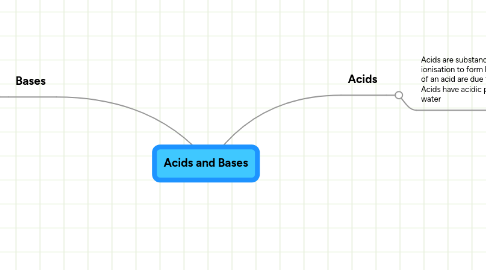
1. Bases
1.1. A base is a substance that reacts with an acid to give a salt and water only. A base also produces hydrocide ions, OH- when it is dissolved in water to form alkalis
1.1.1. Bases are usually metal oxides or metal hydroxides. Many bases are insoluble in water. Bases that can dissolve in water form solutions called alkalis.
1.1.2. The ability of alkalis to neaturalise acids is due to the presence of these hydroxide ions
1.2. Alkalis
1.2.1. Physical propertise of alkalis
1.2.1.1. Alkalis feel slippery
1.2.1.2. Edible alkalis have a bitter taste
1.2.1.3. Alkalis change the colour of indicators. For example, red litmus paper turns blue when dipped into an alkaline solution
1.2.1.4. pH of alkaline solutions is greater than 7
1.2.2. Reaction of bases with ammonium salts
1.2.2.1. Alkalis react with ammonium salts to produce salts, ammonia gas and water
1.2.2.2. Ammonia gas is pungent, colourless and turns damp red litmus blue
2. Acids
2.1. Acids are substances that will dissolve in water and undergo ionisation to form hydrogen ions. The properties and reactions of an acid are due to the presence of hydrogen ions, H+. Acids have acidic properties only when they are dissolved in water
2.1.1. Physical properties
2.1.1.1. Acids have a sour taste. For example, vinegar and emon are both sour because they contain ethanoic acid and citric acid respectively
2.1.1.2. Acids change the colours of indicators. For example, blue litmus paper turns red when dipped in acid
2.1.1.3. Acids have pH values of less than 7
2.1.2. Reaction of Acids with Metals
2.1.2.1. Acids react with metals above hydogen in the reactivity series to give salts and hydrogen gas
2.1.2.2. Example: hydrochloric acid + magnesium - magnesium chloride + hydrogen gas
2.1.2.3. Hydrogen gas is tested using a lighted splint. The flame extingishes with a pop sounds
2.1.3. Reaction of Acids with bases
2.1.3.1. Acids react with bases to give salts and water only. Bases are usually metal oxides or metal hydroxides. This process is called neutralisation
2.1.3.2. Example: hydrochloric acid + zinc oxide - zinc chloride + water
2.1.4. Reaction of Acids with Carbonates
2.1.4.1. Acids react with carbonates to give salts, carbon dioxide gas and water
2.1.4.2. Example: Calcium carbonate + hydrochloric acid - calcium chloride + carbon dioxide + water
2.1.4.3. Carbon dioxide gas is tested by using limewater. Observe a white precipitate when CO2 is bubbled in limewater
